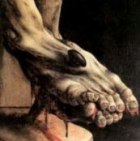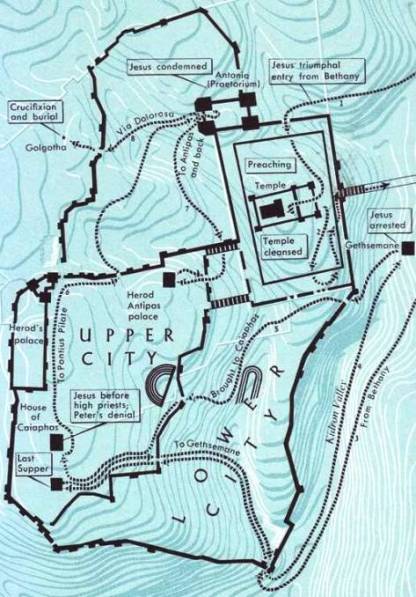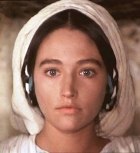Jesus of Nazareth dies on the cross
Questions for Bible study groups
- What were Jesus’ last words? How were they misinterpreted?
- What were the ‘signs and wonders’ that happened at the moment of Jesus’ death?
- Read Bruce Dawes’ poem ‘And a Good Friday was had by all’. What lines affect you most?
- Who were the women present at Jesus’ death, and why did the gospel writers mention them?
In the last moments of Jesus’ life, Nature seemed to turn upside down. This profound moment was witnessed by many people, particularly the centurion and the women who stood watching Jesus’ last agony.
Jesus’ last words on the cross
The last words that Jesus spoke were heart-rending: Eli, Eli, lema sabachthani, My God, My God, why have you abandoned me?
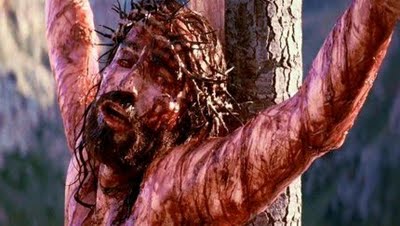 They were the opening words of Psalm 22, a prayer Jesus knew by heart. Read it, the whole psalm, and you will see that Jesus was not reproaching God but trusting him, even in this last extremity. He still prayed to God as to a father.
They were the opening words of Psalm 22, a prayer Jesus knew by heart. Read it, the whole psalm, and you will see that Jesus was not reproaching God but trusting him, even in this last extremity. He still prayed to God as to a father.
Some people standing nearby misunderstood his words. They thought he was calling on Elijah the prophet: ‘Eliyah, Elijah’ – easy to mis-hear the words of a dying man. Many people believed Elijah would one day return, so trying to be kind they offered him sour wine. It was a favourite cheap beverage, said to quench thirst better than water, and it might keep him alive a little longer, in case Elijah did indeed return.
The only way they could give it to Jesus was in a sponge raised on a stick. They (or the soldiers) would only have had to lift it a little way above their heads.
Read the blue Gospel text at bottom of page
Signs and wonders in Nature
The gospels record that there were a number of strange, frightening events at the moment Jesus died, as if Nature itself was screaming out in anguish at the death of Christ.

- The sky darkened in an unnatural way, as if the Cosmos was out of balance. It was not a normal eclipse, which would have been impossible at Passover when the moon was full. Neither was it a unique occurrence. Virgil and the Jewish historian Josephus both record a similar event at the death of Julius Caesar: ‘Who dares to say the sun tricks us? He often warns us that hidden troubles threaten… He pitied Rome when Caesar was killed, and hid his shining face in gloomy darkness… and pale ghosts in strange forms were seen in the dark of night.’ Virgil, Georgics 1.466-9 …those who were the authors of great injustice towards men, and of great wickedness towards the gods; for the sake of which it was that the sun turned away his light from us, as unwilling to view the horrid crime they were guilty of in the case of Caesar.’ Josephus, Antiquities, 14:309
- The curtain of the great Temple in Jerusalem was torn from top to bottom. According to Josephus (Wars of the Jews 6.5.288-315), there were a series of unexplained occurrences in the Temple that were seen as omens of destruction. Temple worship was already being replaced by prayer and study in the local synagogues, and would cease altogether after the destruction of Jerusalem in 70AD. But the torn curtain in the Temple may have symbolised something more simple: Jews tore their main garment when they heard that someone they loved had died; God tore his garment, the curtain of the Temple, when his Son died. Moreover, the curtain was a barrier between God and worshippers; now, at the death of Jesus, people had access to God.
- An earthquake, not unusual in this part of the world
- The opening of the tombs as a result of the earthquake
- The rising of saints/the dead, who walked the streets of Jerusalem
 Did the land really turn dark?
Did the land really turn dark?
Did corpses walk the streets of Jerusalem?
Was there a terrible earthquake?
If you worry about this, you are missing the point.
This is apocalyptic language, symbolic, similar to the Book of Revelations. The writers of the gospel were familiar with this type of writing, and assumed that their audience would be too. Chaos in Nature was an apocalyptic image.
The gospel-writers wanted to convey the cosmic tragedy of Jesus’ death.
Read the green Gospel text at bottom of page
The centurion
Jesus’ crucifixion was supervised by a Roman officer, a centurion. What did he see when he looked at Jesus? Not just a man who trusted God even through dreadful suffering, but one who forgave all those responsible for his death. This was true nobility – and courage that a Roman soldier could appreciate.
And a Good Friday was had by all by Bruce Dawe
You men there, keep those women back
and God Almighty he laid down
on the crossed timber and old Silenus
my off-sider looked at me as if to say
nice work for soldiers, your mind’s not your own
once you sign that dotted line Ave Caesar
and all that malarkey Imperator Rex
Well this Nazarene
didn’t make it any easier
really – not like the ones
who kick up a fuss so you can
do your block and take it out on them
Silenus held the spikes steady and I let fly
with the sledge-hammer, not looking
on the downswing trying hard not to hear
over the women’s wailing the bones give way
the iron shocking the dumb wood.
Orders is orders, I said after it was over
nothing personal you understand – we had a
drill-sergeant once thought he was God but he wasn’t
a patch on you
then we hauled on the ropes
and he rose in the hot air
like a diver just leaving the springboard, arms spread
so it seemed
over the whole damned creation
over the big men who must have had it in for him
and the curious ones who’ll watch anything if it’s free
with only the usual women caring anywhere
and a blind man in tears.
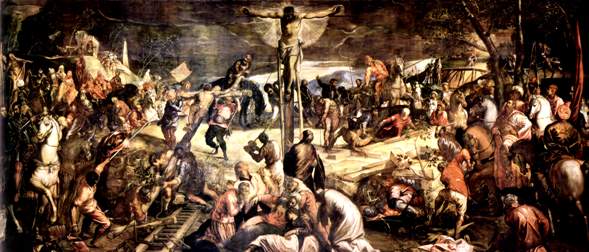
Read the red Gospel text at bottom of page
The women at Jesus’ death
Crucified men were often surrounded by relatives and friends.
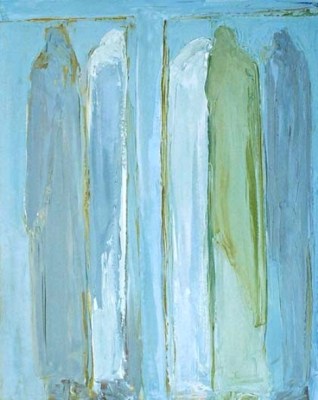 In Jesus’ case, these were mostly women: Mary Magdalene, Mary the mother of James and Joses, and Salome who was the wife of Zebedee and mother of James and John. As a precaution they stood at a distance from the cross.
In Jesus’ case, these were mostly women: Mary Magdalene, Mary the mother of James and Joses, and Salome who was the wife of Zebedee and mother of James and John. As a precaution they stood at a distance from the cross.
They had followed Jesus – literally (to Calvary) and as his disciples in the years before his death. Faithful to him during his ministry, they were faithful to the bitter end. They stood in stark contrast to the male disciples who fled – though it must be said that the women were in less danger than the men.
Why do the gospel writers mention the women, when they largely ignored them during Jesus’ ministry? Because these women were direct witnesses to the three major events of Christianity: the death of Jesus, his burial, and the resurrection.
Read the black Gospel text at bottom of page
Mary, Jesus’ mother, and John the disciple
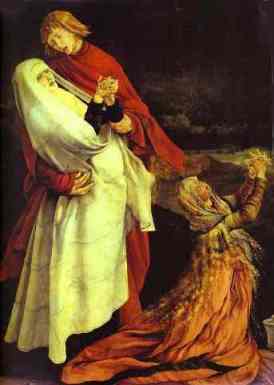 In the ancient world, a dying person could entrust his female relations, especially his mother, to the care of another person. The ancient writer Lucian records a last will and testament where a man called Eudamidas
In the ancient world, a dying person could entrust his female relations, especially his mother, to the care of another person. The ancient writer Lucian records a last will and testament where a man called Eudamidas
‘left behind him an aged mother and a daughter of marriageable years;–the will, then, was as follows: To Aretaeus I bequeath my mother, to tend and to cherish in her old age: and to Charixenus my daughter, to give in marriage with such dowry as his circumstances will admit of.’ Lucian, Toxaris, 22.
Even a crucified man had the right to do this.
Now, even in this desperate moment as Jesus hung on the cross, he was concerned for his mother Mary. He asked his closest friend, ‘the disciple whom he loved’, to care for her after he was gone. A woman alone in the ancient world was easy prey, and clearly he did not wish his mother to come to harm.
The name of the disciple is not given and the incident appears only in John’s gospel. Commentators have suggested that this may be because it was a memory of someone who was there, who remembered what was said but told it as a personal anecdote, not wanting to mention his own name.
Read the purple Gospel text at bottom of page
Summary
There is a deep vein of irony running through the Passion narrative. For example
- sinful people try to thwart Jesus, but their actions merely help him to accomplish the purpose he came for, and so they end up fulfilling God’s purpose
- Judas, one member of the Twelve, betrays Jesus, while the others, who have insisted that they will always be loyal, end up abandoning him
- the Sanhedrin trial and the hearing before Pontius Pilate are supposed to represent justice, but they condemn an innocent man to death
- a number of people mock Jesus by sarcastically calling him Son of God and King of Israel (Caiaphas, Pilate, the people at the cross), without realising they are speaking the truth
- when so many have failed to recognise Jesus for who he truly is, it is a Roman centurion who says that ‘this was truly the Son of God’.
What happened next? See Burial of Jesus
Return to top
What the Gospels say
1. Jesus’ last words. Read the blue text
2. Signs and wonders. Read the green text
3. The centurion. Read the red text
4. Witnesses to Jesus’ death. Read the black text
5. Jesus’ mother Mary and John the disciple. Read the purple text
Matthew 27:45-56
45 From noon on, darkness came over the whole land until three in the afternoon. 46 And about three o’clock Jesus cried with a loud voice “Eli, Eli, lema sabachthani?” that is, “My God, my God, why have you forsaken me?” 47 When some of the bystanders heard it, they said “This man is calling for Elijah.” 48 At once one of them ran and got a sponge, filled it with sour wine, put in on a stick, and gave it to him to drink. 49 But the others said, “Wait, let us see whether Elijah will come to save him. ” 50 And Jesus cried again with a loud voice and yielded up his spirit.
51 And behold, the curtain of the temple was torn in two, from top to bottom; and the earth shook, and the rocks were split; 52 the tombs also were opened, and many bodies of the saints who had fallen asleep were raised, 53 and coming out of the tombs after his resurrection they went into the holy city and appeared to many.
54 When the centurion and those who were with him, keeping watch over Jesus, saw the earthquake and what took place, they were filled with awe, and said, “Truly this was the Son of God!”
55 There were also many women there, looking on from afar, who had followed Jesus from Galilee, ministering to him; 56 among whom were Mary Magdalene, and Mary the mother of James and Joseph, and the mother of the sons of Zebedee.
Mark 15:33-41
33 And when the sixth hour had come, there was darkness over the whole land until the ninth hour. 34 And at the ninth hour Jesus cried with a loud voice, “E’lo-i, E’lo-i, la’ma sabach-tha’ni?” which means, “My God, my God, why hast thou forsaken me?” 35 And some of the bystanders hearing it said, “Behold, he is calling Elijah.” 36 And one ran and, filling a sponge full of vinegar, put it on a reed and gave it to him to drink, saying, “Wait, let us see whether Elijah will come to take him down.” 37 And Jesus uttered a loud cry, and breathed his last.
38 And the curtain of the temple was torn in two, from top to bottom.
39 And when the centurion, who stood facing him, saw that he thus breathed his last, he said, “Truly this man was the Son of God!”
40 There were also women looking on from afar, among whom were Mary Magdalene, and Mary the mother of James the younger and of Joses, and Salome, 41 who, when he was in Galilee, followed him, and ministered to him; and also many other women who came up with him to Jerusalem.
Luke 23:44-49
44 It was now about the sixth hour, and there was darkness over the whole land until the ninth hour, 45 while the sun’s light failed; and the curtain of the temple was torn in two.
46 Then Jesus, crying with a loud voice, said, “Father, into thy hands I commit my spirit!” And having said this he breathed his last.
47 Now when the centurion saw what had taken place, he praised God, and said, “Certainly this man was innocent!”
48 And all the multitudes who assembled to see the sight, when they saw what had taken place, returned home beating their breasts. 49 And all his acquaintances and the women who had followed him from Galilee stood at a distance and saw these things.
John 19:28-34
25 But standing by the cross of Jesus were his mother, and his mother’s sister, Mary the wife of Clopas, and Mary Magdalene. 26 When Jesus saw his mother, and the disciple whom he loved standing near, he said to his mother, “Woman, behold, your son!” 27 Then he said to the disciple, “Behold, your mother!” And from that hour the disciple took her to his own home.
28 After this Jesus, knowing that all was now finished, said (to fulfil the scripture), “I thirst.” 29 A bowl full of vinegar stood there; so they put a sponge full of the vinegar on hyssop and held it to his mouth. 30 When Jesus had received the vinegar, he said, “It is finished”; and he bowed his head and gave up his spirit.

